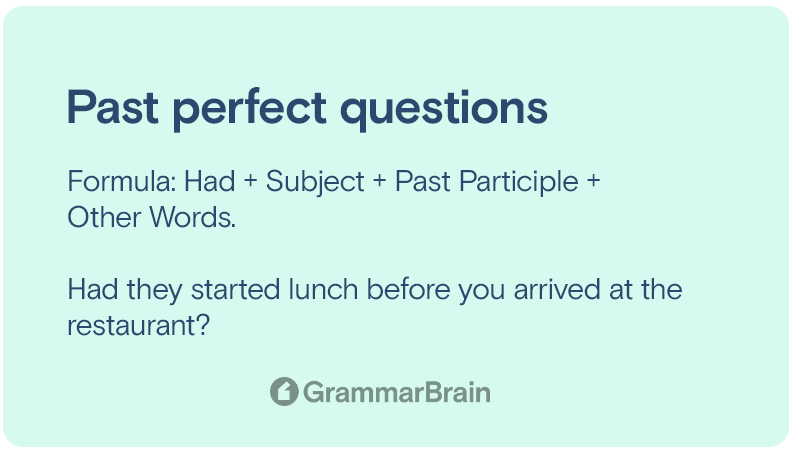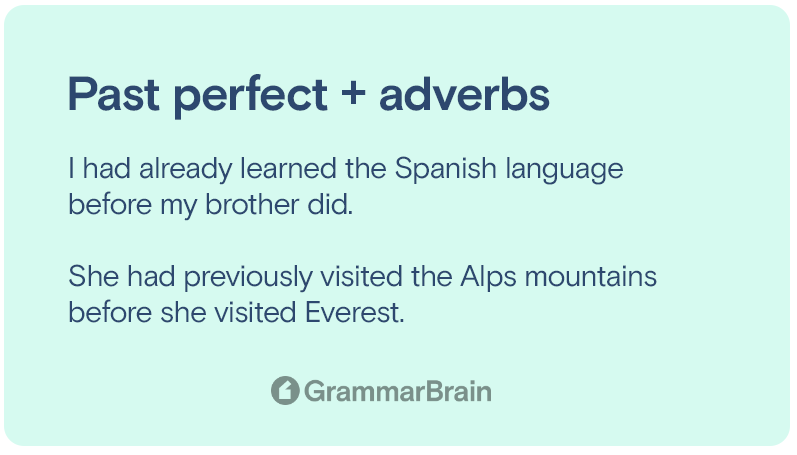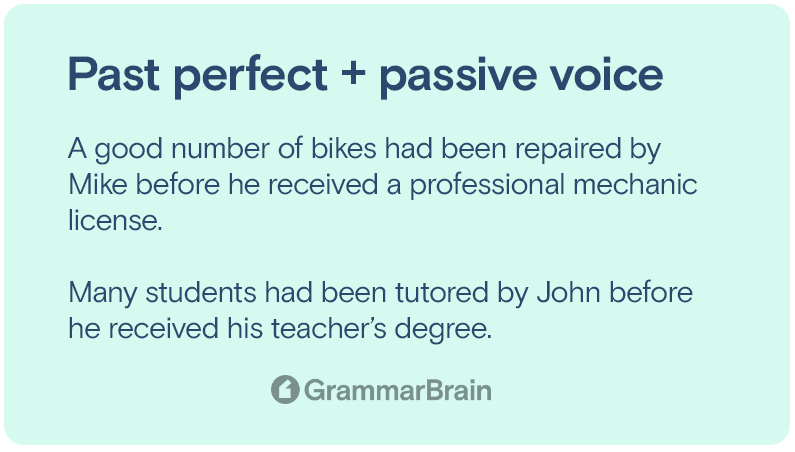Past perfect is one of the tenses in English grammar. It expresses an action that took place first, before another action in the past. For example, Shawn had eaten lunch before I ate lunch. In the first segment of the sentence, the action has happened first before the action in the second segment of the sentence.
Here is the structure to form a past perfect sentence.
What is the structure of past perfect and its examples?
The past perfect is constructed using “subject + had + past participle + other words”. Here are a few examples of the past perfect tense.
| Tense | Function | Rule | Example |
| Present simple | Helps to describe habits, facts, actions, and truth that are not affected by time | Ist form of verb + s/es | He loves pizza. |
| Past simple | Helps to describe events that have happened in the past | IInd form of the verb | She wore a beautiful dress for the party. |
| Future simple | Helps to describe events that will happen in the future | Will/ shall + Ist form | He will go to New York tomorrow. |
| Present perfect | Helps to describe the relevance of past events in the present moment | Has/ have + IIIrd form of the verb | I have learned to ride a bike. |
| Past perfect | Helps to describe events that happened prior to other events in the past | Had + IIIrd form of the verb | She had finished the paper before leaving the hall. |
| Future perfect | Helps to describe events that will be completed between now and a specific point in the future | Will/ have + IIIrd form of the verb | She will have finished the book by tomorrow. |
| Present continuous | Helps to describe ongoing actions | Is/ am/ are + Ist form + ing | She is reading a book. |
| Past continuous | Helps to describe ongoing events of the past, mostly in relation to another event | Was/ were + Ist form + ing | He was driving to work when the accident happened. |
| Future continuous | Helps to describe future events that will/are expected to continue for a period of time | Will be + Ist form + ing | I will be going to meet my grandparents tomorrow. |
| Present perfect continuous | Helps to describe events that started in the past and will continue into the present | Has/ have been + Ist form + ing | She has been writing a book for the past one year. |
| Past perfect continuous | Helps to describe events that began, continued, and ended in the past | Had been + Ist form + ing | I had been working in this company for ten years when I got the promotion. |
| Future perfect continuous | Helps to describe events that began in the past but will continue until a point in the future | Will/ shall have been + Ist form + ing | I will have been doing business with her for one year. |
Ten examples of past perfect tense
- John had taken a bath before he ate dinner. Here, John completed the action of having the bath first, and then he ate dinner.
- John had already left when Sam arrived at the meeting. In this example, John completed the action of leaving the meeting before Sam arrived.
- He had lost weight before he got married. The person completed the action of losing weight before he got married.
- The teacher had already started the class before I entered. In this sentence, the teacher completed the action of starting the class before the person entered the classroom.
- When they returned home, they found that somebody had stolen their valuables. The action of stealing valuables happened first before the people entered their houses.
- Sam had already watched the movie before we did. Here, Sam had completed the action of watching before others did.
- She had completed decorating the room before I came home. The lady performed the action of decorating the room before the person entered the home.
- Amelie had already cleared the mess when Sam reached the office. In this example, Amelie already completed the action of clearing the mess when Sam reached the office.
- When they arrived, the party had already started. The action of starting the party was already completed before other guests arrived.
- The train had already arrived on the platform before I arrived at the station.
Differences between simple past and past perfect
- Simple past talks about an action that was completed in the past. On the other hand, the past perfect talks about an action that happened before a second action in the past.
- An example of the simple past is “He ate bananas yesterday”. The person completed the action of eating bananas. Here, there is only one completed action taking place in the past. In comparison, “Sam had eaten lunch before Tom offered him lunch”, here, the action of Sam eating lunch completed before Tom offered lunch. One action was already completed before the second action happened.
- Past perfect is constructed using the formula “subject + had + past participle”. On the other hand, there is no formula for constructing a simple past. If the sentence uses a regular verb, “ed” is added to the end of the regular verb to make the sentence simple past. If the sentence uses an irregular verb like “eat”, its past form is “ate”.
Differences between past perfect and present perfect
- The present perfect tense talks about an action that happened in the past together with its result in the present. In comparison, in the past perfect, two actions take place in the past. One action has already been completed before the second action.
- The present perfect is formed using “subject + has/have + past participle + other words”. On the other hand, the past perfect is constructed using “subject + had + past participle + other words”.
- An example of present perfect is “My sister cannot attend the class because she has fractured her hand”. In this example, the fracturing of her hand took place in the past and the present result is that she cannot attend class. An example of past perfect is “She had already fractured her hand before she started gym classes”. Here both actions were completed in the past, one before the other.
Differences between past perfect and future perfect
- The future perfect tense talks about an action that has not been completed yet and will be completed in the future at a specific time. On the other hand, the past perfect talks about actions that have been completed in the past.
- The structure of the past perfect sentence is “subject + had + past participle + other words”. The formula of future perfect is “subject + will/shall + have + past participle”.
- An example of future perfect is “In two weeks, I will have collected $20,000 for charity”. Here the action will be completed in the future at a specific time. In comparison, “I had donated to the charity before my brother did” is a past perfect example where two actions have been completed in the past. One action happened before the other.

How to construct negative sentences using past perfect
Constructing negative sentences is possible using the past perfect tense. Adding the “not” between “had” and “past participle” helps in constructing negative sentences. Here is the structure.
Structure: Subject + had + not/never + past participle + other words.
Here are a few examples of negative sentences using past perfect.
Examples:
- Sam had not decided on the venue for the party so we stayed back at the hotel.
- He hadn’t (contracted verb) invited the company to the defense expo so the company skipped the expo.
- They had not booked flight tickets to Hawaii so they canceled their vacation.
- I had never visited a five-star hotel before I visited Hyatt.

How to construct questions using past perfect
Questions are constructed using past perfect by exchanging the positions of “had” and “subject”. Here is the formula.
Formula: Had + Subject + Past Participle + Other Words.
Here are a few examples.
Examples:
- Had they started lunch before you arrived at the restaurant?
- Had she completed the exam before the bell rang?
- Had Sam joined the army before John joined the army?
Constructing negative questions is also possible with past perfect.
Examples:
- Hadn’t he finished the project before I completed it?
- Hadn’t Jane completed her homework before I arrived?
Constructing past perfect sentences using “Just”
The word “just” is used in a past perfect sentence to talk about an action or event that happened a short time earlier than the second event in the past. Here are a few examples to understand how the word “just” functions in a past perfect sentence.
Examples:
- Sam had just left the shopping mall before Jane arrived at the mall. In this sentence, Sam left the mall a moment ago before Jane arrived.
- I had just removed the clothes from the balcony before it started to rain.
- The burglar had just disappeared from the crime scene when the police arrived.
The employee had just left the room before his boss entered.

Constructing past perfect sentences using adverbs
Past perfect sentences are also created using adverbs. Here is a list of a few examples.
Examples:
- I had already learned the Spanish language before my brother did.
- She had previously visited the Alps mountains before she visited Everest.
- The cats had suddenly disappeared before the dogs arrived.

Constructing past perfect sentences in passive voice
Examples:
- A good number of bikes had been repaired by Mike before he received a professional mechanic license.
- Many students had been tutored by John before he received his teacher’s degree.
Inside this article
Fact checked:
Content is rigorously reviewed by a team of qualified and experienced fact checkers. Fact checkers review articles for factual accuracy, relevance, and timeliness. Learn more.
Core lessons
Glossary
- Abstract Noun
- Accusative Case
- Anecdote
- Antonym
- Active Sentence
- Adverb
- Adjective
- Allegory
- Alliteration
- Adjective Clause
- Adjective Phrase
- Ampersand
- Anastrophe
- Adverbial Clause
- Appositive Phrase
- Clause
- Compound Adjective
- Complex Sentence
- Compound Words
- Compound Predicate
- Common Noun
- Comparative Adjective
- Comparative and Superlative
- Compound Noun
- Compound Subject
- Compound Sentence
- Copular Verb
- Collective Noun
- Colloquialism
- Conciseness
- Consonance
- Conditional
- Concrete Noun
- Conjunction
- Conjugation
- Conditional Sentence
- Comma Splice
- Correlative Conjunction
- Coordinating Conjunction
- Coordinate Adjective
- Cumulative Adjective
- Dative Case
- Determiner
- Declarative Sentence
- Declarative Statement
- Direct Object Pronoun
- Direct Object
- Diction
- Diphthong
- Dangling Modifier
- Demonstrative Pronoun
- Demonstrative Adjective
- Direct Characterization
- Definite Article
- Doublespeak
- False Dilemma Fallacy
- Future Perfect Progressive
- Future Simple
- Future Perfect Continuous
- Future Perfect
- First Conditional
- Irregular Adjective
- Irregular Verb
- Imperative Sentence
- Indefinite Article
- Intransitive Verb
- Introductory Phrase
- Indefinite Pronoun
- Indirect Characterization
- Interrogative Sentence
- Intensive Pronoun
- Inanimate Object
- Indefinite Tense
- Infinitive Phrase
- Interjection
- Intensifier
- Infinitive
- Indicative Mood
- Participle
- Parallelism
- Prepositional Phrase
- Past Simple Tense
- Past Continuous Tense
- Past Perfect Tense
- Past Progressive Tense
- Present Simple Tense
- Present Perfect Tense
- Personal Pronoun
- Personification
- Persuasive Writing
- Parallel Structure
- Phrasal Verb
- Predicate Adjective
- Predicate Nominative
- Phonetic Language
- Plural Noun
- Punctuation
- Punctuation Marks
- Preposition
- Preposition of Place
- Parts of Speech
- Possessive Adjective
- Possessive Determiner
- Possessive Case
- Possessive Noun
- Proper Adjective
- Proper Noun
- Present Participle
- Prefix
- Predicate



